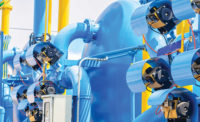Properly selected automated controls to minimize chiller plant energy, power consumption, and the cost of operations are essential for overarching chiller plant performance.
Effective plant managers are driven to operate their plants at the lowest life cycle costs possible. This begins with the initial first cost of construction and recurring plant lifecycle operating costs, while still accounting for all the complexities and interaction among major plant equipment components.
Due to variations of chilled water plant design configurations (constant flow, variable flow, primary/secondary, etc.) and individual system equipment components, meeting this goal is quite difficult. It is feasible, however, to reduce chiller plant lifecycle costs by focusing on individual system components (pumps, control valves, etc.), using sensors (temperature, flow, differential pressure, etc.) to measure and verify that the chiller plant is functioning at or close to its optimal lifecycle level effectively by using automated control techniques that are simple and practical enough to be used.
Understanding their individual equipment limitations and operating tolerances, major chiller manufacturers over the years have developed control algorithms using principles of thermodynamics, heat transfer, and pumping system hydronics. Plant managers should always be aware of these limitations whenever additional control strategies are applied by a building management system (BMS). Chiller plants by design cannot respond instantaneously to a measured change in cooling requirements. However, the use of a high-speed network to share measured information that can then be extracted for analysis by a BMS is recommended.
Oftentimes, chiller packages do not directly control the pumping system (chilled water pumps, condenser water pumps) and rely on a pumping system that is primarily controlled by the BMS. Because of this relationship, “plant load changes” and “time” must be managed by the BMS to reconcile both time of response and sensitivity.
Controller Selection
BMS controllers must have the capability to directly communicate to individual package chilled water systems and pumping systems. The BMS must be capable of two-way communications to chiller plant applications requiring pumps using VFDs. Select non-proprietary digital controllers with both built-in BACnet and LON communications capabilities that can perform all alarming, energy monitoring, system performance archiving, event management, and scheduling.
Most chiller manufacturer’s allow for BACnet or LON communications but may only share limited data or only allow for certain parameters to be remotely adjusted. Always discuss with the chiller manufacturer “what data” is available and “which chiller parameters” can be modified. Select controllers with a minimum of 133 MHz microprocessor with an on-board memory of 72 MB for chiller applications whenever additional control strategies are required to be performed by the BMS.
Control Accuracy
All digital controllers serving the plant should use a full 16-bit analog-to-digital (A/D) converter, versus 10- or 12-bit A/D convertors. Using controllers with a 16-bit converter versus a 10- or 12-bit A/D provides an increase in overall finite control (output from controller, 0-10v, 4-20ma, etc.), measurement (such as temperature, pressure, water flow, etc.), and resolution due to the controller’s microprocessor ability for higher sampling rates. Whenever a controller stores temperature or pressure point information to be used in a control equation (sequence), information must first be stored in a fixed-length variable. A controller with 16-bit A/D capabilities can hold a greater capacity of information than a 10- or 12-bit A/D, providing better signal quality and greater control.
Advanced Control Algorithms
Digital controllers used for plant applications must be capable of providing continuous loop control using proportional adaptive control software algorithms. BMS adaptive control software is capable of monitoring several chiller plant variables (temperatures, pressures, equipment on/off statuses, etc.) dynamically as they change, seeking out relational patterns, then quickly modifying its output behavior to improve on the overall control response based on the patterns observed.
Adaptive control software algorithms help to reduce inherent operational control inefficiencies by aiding in preventing unstable control at low loads and during equipment sequencing.
Sensor Selection and Placement
Often neglected by plant designers is selecting the correct sensor technology and proper sensor placement for optimal system performance monitoring. Plant designers must understand what performance level they are seeking. For example, a variable flow primary chilled water system bypass control valve installed near chillers is best for chiller energy conservation with an initial reduction in installation cost (less wiring), although it is more difficult to tune the temperature control loop and slower to respond to system load demands.
If the bypass control valve is remotely installed away from the chillers (more control wiring required), the BMS upon measuring small fluctuations in system pressure will be capable of a faster response, resulting in better system control while maintaining primary chilled water loop at colder temperatures to meet load demands.
During design, select chilled water temperature transmitters with a minimum measurement accuracy of +.5˚F. Differential water pressure transmitters for chiller plant applications should be selected with a reference accuracy of +1% of full span and all flowmeters should be selected with an accuracy of ±1% of flow over a ±40 fps flow range with a flow sensitivity of 0.001 fps at any flow rate, including during “no flow” conditions.
Carefully installing BMS sensors and control valves in both the plant’s main and distribution piping will help to confirm the delivery of the proper temperature and flow requirements required at each chiller, at chilled and condenser water branch locations, and to all facility areas during various load conditions.
Final Thoughts
From the earliest times, comfort has been a goal of man so that he can live and work in all parts of the world at all times. Today, we expect the places where we live and work to be not only heated but also cooled when needed. We expect precise comfort conditions at a low operating cost with safety and efficiency.
Facility managers charged with maintaining and operating a chiller plant must seek to understand the interdependencies and relationships between available BMS control technologies as it applies to their specific chilled water plant piping configuration. Selecting non-proprietary full 16-bit digital controllers with adaptive control software that can provide both control signal accuracy and quick response for analysis are essential in implementing chiller plant optimization control strategies. ES




